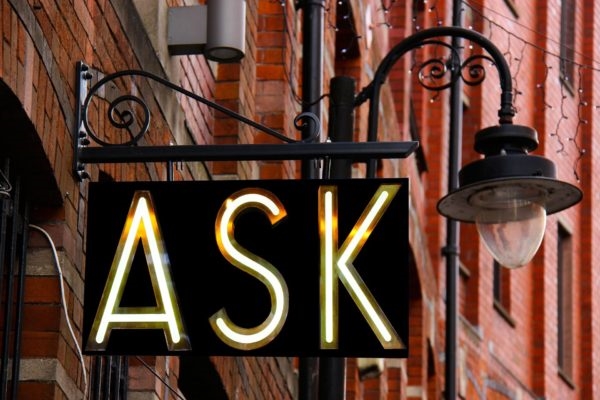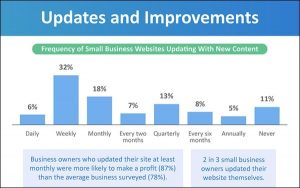— March 23, 2019
If you’re a small business owner embarking on your first response to an RFP (Request For Proposals), you’re probably feeling both excited and apprehensive. You know that winning an RFP competition can be lucrative… but the RFP response process has a bad rap.

Feeling apprehensive as you approach writing an RFP response?
Proposal writing goddess Isabel Gibson, who’s worked on more than 85 RFP responses over 25 years, writes, “Proposals are notorious for burning people out, and at a minimum can certainly be miserable: a mad scramble to meet the deadline, amid conflict within the team.” (The quotes from Gibson in this article are from her book, Proposals: Getting Started and Getting Better, which I highly recommend.)
Bear in mind, however, that RFP responses vary in length and complexity and so are more or less manageable. Communications Consultant Carla Dawes has been involved in more than 30 RFP responses over the past 13 years and she says:
I’ve written proposals completely on my own, worked with teams as small as three people writing a 50 page proposal for small enterprise, and on teams as large as 75 people creating proposals that are binders and binders of technical writing and drawings. I remember once delivering a proposal to Public Works and Government Services Canada (now PSPC) that was one and half pallets of boxes filled with binders. That proposal took a coast-to-coast team of more than 30 of us nearly four months to produce.
You aren’t tackling anything as big and involved! So the situation may not be as daunting as the nightmare you imagined.
Maybe you’ll never love writing RFP responses (also called bids or proposals), but at least you can head into your first battle well armed. I wrote this Ultimate Guide to share what I’ve learned about best practices for writing RFP responses, and to pass on advice from professionals in different industries who are experienced at either writing or receiving RFP responses. There are links to further reading at the end.
Although the points below are in approximate chronological order, some of them will happen simultaneously. Somebody on your team works on costing the project while someone else starts researching the issuing organization, for example. And some are not chronological steps at all, but points to bear in mind at different stages of the process (e.g. copy-paste with care). But let’s start at the beginning.
1. Read and understand the RFP
You can’t get very far until you’ve understood the RFP, so that’s the first step. Gibson writes that, regardless of the size of an RFP and its corresponding response, RFPs have the same six parts:
- Introduction to the opportunity and the client
- Description of the response process
- Description of the Work (products, services, reports, other deliverables)
- Contract terms and conditions
- Response instructions
- Evaluation process and criteria
Keeping these six parts in mind will help orient you when looking at an RFP for the first time.
Every single one of the experts I interviewed emphasized the importance of making sure you understand the RFP.
Dawes says, “Read the entire RFP as soon as you receive it. You’d be surprised how many times I’ve been on teams where not everyone has even reviewed the requirement! All members of your team should read the RFP in its entirety and note any questions you need to discuss and/or ask the client. That is step 1!”
Not all RFPs are well written, and some are written by committees, with parts copy-pasted from other documents. It’s not surprising they’re sometimes unclear. But even if they are well written, they can use unfamiliar terminology. Put in the effort in to understand the language at the beginning of the process.
An official question period is a standard part of the process. Use it. Get as clear as possible in the time available on the client’s requirements and needs. (I’ll refer to the organization or company that issues the RFP as the ‘client’. The organization or business that responds to it — that’s you! — I’ll call the ‘vendor’.)

If you don’t understand something in the RFP, ask questions.
LCol (Ret’d) David Robinson, who reviewed proposals when working on aircraft procurements, says, “Some bids fail to meet the mandatory requirements either because they are bidding on a contract they cannot fulfill or they fail to understand the requirements.” He thinks the most common mistake in RFP responses is “failing to ask questions when [vendors] do not understand the RFP, resulting in a non-compliant bid.”
However, don’t break any rules when you approach the client during the RFP process. For example, a government office might issue an RFP and state that they have a specific staff person assigned to answer vendors’ questions. So you would break the rules if you call up your acquaintance who works in the same office to ask them a question.
This levels the playing field to a certain extent. If you don’t have connections at the organization, but your competitor does, you both have to communicate with the same person.
But Software Consultant Daniel Mallett cautions, “Be careful with asking questions, though, because sometimes they’re made public, in which case your competitors might see your questions and the answers.”
Gibson has a different kind of caution:
Proposal newbies always wonder why the veterans are so cynical about asking questions. Like newbies everywhere, they have a touching faith in the efficacy of the process. So they craft their questions and they wait. And wait. And wait. Eventually, they get an answer that doesn’t really give them the information they need, and they have to decide whether they have time for another cycle.
This is one reason it’s best to influence the RFP before it’s even issued, which incumbent vendors and those with some other personal connection to the client can sometimes do. Nevertheless, ask questions anyway. Increase the chances of a helpful response by making sure your questions are clear, concise and polite. Explicitly reference the place in the RFP that your question applies to. Make it easy for the person responding to the question and reduce the chances of getting an unhelpful response like, “Read the RFP”.
2. Pay attention to the evaluation criteria
RFPs typically state the criteria the client will use to rank the proposals they receive. This will help you see where you need to focus your attention. If cost is 10% of the grade but methodology counts for 40%, you’ll know that clearly explaining the details of your methodology is more important than offering rock bottom prices.
Mallett says, “It’s obvious really. Focus on the factors that account for the biggest scores. Think about how you could respond before you start, so you don’t waste your time responding if it’s not a good idea.” If your main selling point is that your products are low cost, an RFP where cost is only 10% of the grade may not be a good fit for you.
3. Figure out your price
On the one hand, you want to win the contract by quoting low. And for government projects, Robinson says, “Cost is usually, in some way, the most important factor. Lowest bid usually wins.” Gibson agrees: “In government procurements, assuming that low price is the real basis of contract award is the safer way to go”.
On the other hand, you don’t want to base your price on wishful thinking and thus unintentionally under quote. Diane Brayman reviewed numerous RFP responses in her former role as Manager of Visitor Services at the Legislative Assembly of Alberta. She recommends figuring out, honestly and with actual data, how much it’ll cost you to complete the proposed project competently. She notes:
Being cheapest isn’t necessarily the best. In fact, offering an unrealistically low cost can be a red flag, as it may suggest that you don’t fully understand the scope of the project. Admittedly, some contracts are awarded based solely on cost, provided the mandatory minimum requirements are met; however, more complex projects will focus heavily on understanding and meeting the creative and/or technical aspects of the project. As well, some government contracts are awarded on a “cost per point” basis, which means that the bid price is divided by the total points awarded for all the other criteria. Therefore if you have a very strong proposal you could still win the contract even if your price is not the absolute lowest one. Study the evaluation criteria carefully as the methodology should be made clear in the RFP as to whether the selection will be based on lowest price or overall value.
Make sure you know what’s included in the scope of work. If something is outside the scope, but you assume it’s included (perhaps because you’ve always included it in the past), then this will unnecessarily increase your quote and make you less competitive.

Figure out the minimum amount of profit you’d be happy with.
So your estimate has to be based on good information, not guesswork, and, at least for government projects, “the profit margin you bid should be the minimum you’ll get, not the maximum”. [Gibson]
As you get into more detail, your estimate of your costs may change, and this may change your decision about whether to respond to the RFP. For big, complex projects, it’s impossible to do pricing near the beginning of the response process. There are too many unknowns at that stage. But for a smaller project, you can at least have a ball park figure at the beginning.
You can offer additional options, but make sure it’s clear that these are indeed options, and not part of your base offer. Make sure your base offer is compliant and don’t include anything additional if it’s going to increase your cost.
Of course, assuming you’d like to do business with the client beyond this project, consider settling for less profit this time around because you anticipate a long term relationship. So for your first ever RFP, it might be sensible to get in the door with a lower level of profit than is ideal.
This is called “buying a contract”, which Gibson defines as follows: “Bid lower than cost or lower than cost-plus-a-reasonable-markup to be more sure of winning a contract. Use it to break into a new industry or to discourage other competitors from entering your own.” But keep in mind Brayman’s point above — don’t give the impression you’re ignorant or unrealistic about the costs.
If the client is a non-governmental organization, or a private business, you may have more leeway when it comes to pricing. You might quote higher than your competitor but use your marketing skills to sell your value to the client.
4. Decide whether to respond
Once you understand the RFP, know the criteria it’s evaluated on, and have figured out roughly how much to charge, you’re in a position to decide whether to bother. If 50% of the scoring is for experience, but you’re new to the industry, consider skipping this one.
Be realistic about what you can achieve. There’s no point turning in a half-assed RFP response (and it could even harm your reputation) but creating a good one — even a small, non-technical one — takes a lot of time and effort. The president of Guido & Associates Engineers Ltd., Ken Guido P. Eng., says you must be “sure the investment in responding to the call is appropriate for the size of the overall project or requirement.” Given your chances of success, and the likely return on this project, is your investment of time, effort and money worth it?
Even a small proposal sucks resources from other activities, both marketing and operational. The opportunity under consideration must be worth the ‘opportunity cost’, as it were: the estimated value of opportunities foregone to pursue this one. [Gibson]
Even if your chances of winning are low, it might be worth responding anyway. First, it’s practice for when you have a better chance of winning, especially if you make sure you get feedback at the end of the process. And second, it can put you on the client’s radar. Maybe they won’t choose you for this project, but they’re now aware of you and may keep you in mind for something else they might need in future.
Once you’ve decided to respond, Landon Aldridge, VP Operations at SkyFire Energy Inc., recommends planning first:
As a first timer, I would suggest breaking up all of the parts of the response and putting a plan together on how you want it to read/look. Estimate the time involved for each part and build a schedule based on that. Give yourself some bonus time at the end just in case things don’t go as planned. If possible, have the response ready the day before so that you have time for small changes/clean up. Keep track of how much time each part took and use that data for the next proposals.
5. Do background research
Once you’ve decided to go ahead, research the client beyond the words in their RFP. Can you find out more about their needs, their pain points, their budget (if this isn’t explicitly stated)? Can you find their recent strategic plans and annual reports online? See if they’ve been in the news in the last little while. If you can figure out how this project likely fits into their overall business plan, make use of that information when you present the benefits your business can provide.
You already know their immediate intention for this project. Let’s suppose it’s to get a new website. How does that intention fit into their broader business goals and needs?

Do background research on the client.
Maybe they need a new website because their image has been tarnished and the website is part of an overall re-branding. Perhaps their old website isn’t mobile-friendly, so you can infer they’ve been losing traffic. Is the goal of their fresh look to attract new customers? They may be unsure of all the benefits of a new website. Guido says you should “be aware of who your customer is and what kind of help they need. Sometimes, you may need to educate them”.
You’re likely familiar with the marketing advice to focus on the benefits you can provide for your customer or client, rather than on the features of your product or service. Knowing the client’s broader goals will help you focus even further, and decide which of those benefits to emphasize.
Even though they’re obvious to you, don’t assume the benefits are obvious to the client. And make sure the benefits are clear to both technical expert evaluators and intelligent lay readers. For the expert, make sure you don’t gloss over any details; for the layperson, keep it simple but don’t talk down to them.
When you get to the editing and design stage, make it easier for both types of reader to find the content that’s relevant to them by using side bars or boxes. A box that goes into the details enables the layperson to skim or skip that part, while the expert knows to pay attention. A call-out box can highlight the overall view of the project and emphasize the importance of reading and understanding that part.
6. Get clear on why you are the best choice
You now have a good understanding of what the client needs. But why should they choose you? You need to sell your value. Even if you offer the lowest bid for a government contract, you still need to persuade the readers that you offer value for money.
Why should the client pay you instead of any of the other (possibly cheaper) respondents? Or why should they choose you instead of not hiring anyone this time around and putting off this project? Get clear on what’s special about you. Do you have lots of experience with this type of project? Or this type of client, so you understand their needs? Are you local? Do you have a large team with lots of diverse talent? Or a small team able to dedicate itself to this project? Do you have a fantastic portfolio to show off? Whatever it is, get clear on it.
Instead of listing your generic selling points, Gibson recommends developing “a handful of statements that capture what’s unique about you and your solution for this opportunity, for this client”. These are your themes that you want to weave throughout the entire proposal.
Experience is always good, but don’t despair if you haven’t done a project that’s exactly the same as the one in this RFP. Brayman says, “If you don’t have direct experience, show how your skills in a different area are transferable to this project.”
Notice that apart from taking notes so you don’t forget anything, you haven’t even started writing yet! For a good RFP response, thorough preparation is essential. But now let’s turn to the writing.
7. How to complete the checklist
Sometimes the client will include a checklist of things they’re looking for, with a Yes/No column for potential vendors to fill in. Brie Lam was the Director of Business and Product Development, Operational Risk & Regulatory Compliance at IHS Markit Canada. She says that the client may filter proposals based on this checklist, so she recommends that you adjust your responses accordingly.

A yes/no checklist might be to filter vendors, so respond carefully.
If you’re a good fit for the project, you don’t want to get filtered out — but you need to be honest too. She says, “For example, if you are able to partially cover a client’s needs, a positive response of Yes… with clarification that you are able to partially cover may be the best approach.”
8. What to write first
Where should you start? With a table of contents and an outline.
The table of contents gives you the big picture of all the sections to include and the section numbers, so you can cross-reference easily. Your outline gets a little more detailed and includes the sub-sections and points you’ll make in each section. This outline is your guide throughout the writing process. Refer to it repeatedly to keep on track.
After that, it’s more important to start somewhere, rather than get stuck because you don’t know how to write the beginning. This goes for any type of writing actually. Just. Get. Words. On. The. Page. If you know what to say in section 3, write section 3 first and worry about sections 1 and 2 later.
And always give yourself permission to write a bad — a terrible, horrible, no good, very bad — first draft. Remember William Zinsser’s words in his classic book On Writing Well: “Professional writers rewrite their sentences over and over and then rewrite what they have written.”

Writing a bad first draft is fine. Keep editing until it’s good. And then edit some more, until it’s excellent!
Revision is an essential part of the writing process, not a sign that you’re bad at writing. But before you can revise them, you need words on the page to revise!
The order that you write the sections doesn’t matter. They will all be revised, and parts may get moved from one section to another. The order in which you submit the response does matter though. If the client asks for items to be submitted or presented in a particular order, make sure you follow those instructions.
In fact, Brayman recommends that you follow the order of the RFP, even if the instructions don’t specify an order. This is because that order made sense to the client when they wrote the RFP, so it’s likely that your response will make sense to them if it follows the same order in return. It also helps you make sure you cover everything in the RFP. She also recommends including a table of contents at the front of your proposal, even if the client doesn’t require one. Pay attention to the required order when you prepare your table of contents and outline.
(Oh, and do take the word or page count seriously. The client’s not joking.)
9. The executive summary
The executive summary (if one is required) will likely be near the beginning of your proposal, and it summarizes what’s to come. But it’s not just a condensed summary of your entire proposal. In particular, you need the executive summary to grab the reviewer’s attention. The reviewer may decide whether to invest the time in reading the rest of your proposal on the basis of your executive summary. So in a sense the executive summary is a sales tool — but not in salesy language.
Brayman says, “It gives the reviewer an overall view of what to expect as to the benefits of going with that contractor. It should not be too long (the rule of thumb is 5-10% of the length of the proposal) and it should be persuasive, not too general but not getting into specific details either.”
Throughout your proposal, you should use the client’s language as much as possible — but this goes a bazillionfold in the executive summary. The executive summary is where you talk about their problems, their needs, their pain points, their goals… and how they will benefit if you’re chosen.
The client needs to feel heard and understood when they get your response in front of their eyeballs. If a vendor doesn’t even understand the client’s problem, why should the client bother reading on?
10. Copy-paste with care

Don’t embarrass yourself with sloppy copy-pasting.
It’s good to have some boilerplate ready to go, for proposals as well as other purposes. Mallett says that his company requires employees to update their resumes every six months, so they’re always current if they’re needed on short notice — and RFP responses often require a speedy turnaround time, which is another reason they can be stressful and unpleasant.
So, by all means, copy-paste your team’s (short!) bios, your company’s (short!) history, and your testimonials or case studies, but for almost everything else — the benefits you can offer, the timeframe, the pricing — you need to be thinking about the client. This proposal must be tailor made for this client. An ill-fitting, off-the-rack item will not do.
When it’s time to write your second RFP response, don’t copy-paste from your first one. Restrict copy-pasting to your boilerplate material (bios, company history and testimonials). Each client needs special treatment, which is why RFP responses are a lot of work. (And, heaven forbid, you don’t want to accidentally copy-paste in the name of one of your previous clients! *Cringe*)
11. Explain your pricing

Be as explicit as possible when you explain your pricing.
In your proposal, be as explicit as you can about pricing. This is definitely something the client wants to know about. If you’re too vague or seem secretive, they won’t like it and they won’t like you. If your answer to how much something will cost is, “It depends” then do your best to explain what it depends on. So you can say things like, “In such-and-such circumstance, our fee will be $ x; but in these other circumstances, it’ll be $ y.” Your background research in the preparation stage should have given you some information to guide you here.
And remember that you need to sell your value, especially for private sector RFPs. (For public sector RFPs, price is usually paramount but you still need to show you provide value for money.) Your bid might be higher than your competitor’s, but you might have more to offer because you have a better understanding of the project than they do. As Rachel Clarida, Principal and Registered Interior Designer at Hatch Interior Design, says:
We were recently awarded a contract even though our proposal was somewhat higher than a competing firm because we not only showed that we were well suited to the project based on our experience, but also because we added optional services that were not included in the RFP but that we felt were important to executing the project properly.
12. Provide evidence that you’re the best choice
Before you started writing, you got clear on what makes you right for this project. Now you have to show that to the client.

Make good use of statistics to support your case.
The client will want to see examples of your previous work that are relevant to this project and this client, and the more recent the better. But you’ll need to work with what you have. If your most relevant project is not very recent, avoid drawing attention to its date if you can. The reviewer is looking for reasons to reject each response they get and they need to pick something to go on. If you’re confident that you’re a good fit and could do an excellent job of this project, don’t draw unnecessary attention to details that might get you rejected for no good reason.
If you have testimonials or case studies already available, that’s awesome. This social proof should focus on the benefits your customer or client gained. If you have statistics on how you helped previous customers or clients, that’s fantastic. If not, showing the general benefits of the type of thing you do is better than nothing. So even if you don’t have any data on how the website you made for a prior client increased their web traffic, if you have data on how mobile-responsive websites generally increase traffic, that’s good to include.
13. Appearance matters
For some businesses, it’s obvious that visuals are important. Clarida, who is an interior designer, says, “For us, photos of our work say more than 100s of pages of words can, so we include high quality images of past projects to help illustrate what we can do.”
But appearance matters even for businesses that are not visually-oriented. After all, easily distractible humans will be reading your response, not mindless organizations or companies.

Team photos break up text, add a human touch, and show a little of your company culture — such as whether your office is formal or relaxed.
Brayman says, “Make sure your response is well organized, looks good, has a nice layout etc. Use good quality visuals. Your proposal is like a job interview. Appearance matters.”
Features you can use to add visual variety:
- Bulleted lists
- Graphs/charts which make data easier to digest
- Tables
- Headings in a different colour or font
- Logos
- Team photos to add a human touch
- Icons to highlight key points
- Call-out boxes for optional material such as technical details
14. Answer the questions, be clear, and don’t skimp on the details
Non-compliant responses that fail to answer the RFP’s questions are common. (So you’re ahead of the game if you just manage to answer the questions!) But not only do you need to answer all the questions, you need to make sure it’s clear that you have done so and to answer each question so it’s as easy as possible for the evaluator to grade.

Don’t annoy your reader with useless fluff.
Gibson writes, “Be obvious. Make it clear that you’ve met the requirement. If you’re offering more: first, be sure you want to do that, and then make it stand out. If you’re just giving lots of detail, make the main points clear. Make it easy for them to see that your answer is compliant.”
What’s the scope of the project, for the price you’re offering? For example, Clarida says, “We are careful to indicate that we have included up to three meetings in a specific phase of the project… It is important to set realistic expectations in your proposal.”
Bullshit is the enemy of clarity. Brayman says, “Be persuasive, but don’t BS. Be clear, direct, concise. Don’t bother with fluff. If it’s a government RFP, they’ve seen so many responses that they’ll see your fluff for what it is. And it annoys them.”
In addition, Mallett adds, “Don’t lie. Don’t exaggerate.”
And finally, go into detail. Don’t just say what you’ll do. Explain how and why.
15. Editing: Content
Once you’ve got a full draft, it’s time to edit. Move things around. A paragraph you wrote for one section could be better in a different one. (When I’m working on a big writing project, I like to use paper, pencil and highlighters at this stage. The visual and tactile feedback helps me get a better handle on the overall organization. But you do you.)

Answer ALL the questions that were in the RFP. Not the questions you wish they’d asked.
Make sure you’ve included everything and answered all the questions in all their parts, and everything is ready in submission order. Nothing less than 100% compliance is good enough. If you fail to submit even one mandatory item then you needn’t have bothered at all. All your work is wasted.
Don’t answer what you wish they’d asked, or what you think they should’ve asked. Answer what they did ask. If you want to add something that responds to a concern you’re judging the client has but didn’t state, that’s fine. But answer the stated question first.
Gibson writes: “Nothing screams ‘Boilerplate!’ louder, or puts evaluators to sleep faster, than reading answers to questions the RFP didn’t ask, or wading through three pages where one would have been sufficient.”
When you read through at the end, check for a couple of things: Does the client’s name appear more often than yours? Good! That’s how it should be. The client cares about what they can get out of this transaction. Also, when you read each paragraph, is it focused on the benefit to the client, rather than on the features of your product or service? As you read through, keep asking yourself if you’re addressing the question, “What’s in it for them?”
16. Editing: Writing style
Aim to make your response as short as possible, while keeping the necessary information. As Lam says, “Concise responses are more likely to be read in full.”
Check for repetition. Given that different reviewers might be assigned different sections, you might consider making the same point in two sections if it is particularly significant. But definitely don’t make the same point twice in one paragraph.
Delete unnecessary words and sentences.

Make your readers’ lives easier and they’ll like you better.
Don’t use a fancy word like ‘utilize’ when there’s a perfectly good simple word like ‘use’. It doesn’t make you look smart, it just makes your writing harder to read. Have some empathy for the readers who have to wade through your proposal and all of your competitors’! Make your readers’ lives easier and they’ll like you better.
Use the client’s language as much as possible. Their terminology, not yours; their spelling choices, not yours; their acronyms, not yours. Don’t introduce new jargon if you can avoid it.
‘Professional’ doesn’t have to mean dull as dishwater. Use lively language and short paragraphs. Vast walls of text are very unfun to read, especially on a computer screen. Vary the lengths of your sentences.
And, for the love of Zeus, get someone who hasn’t been working on the document to proofread it.
The Grants Director at the Edmonton Arts Council, Stephen Williams, has reviewed only a few RFP responses in 15 years and typically receives grant applications. But he thinks that much the same advice applies: “My advice is not rocket science — be clear, understand what you are being adjudicated on, know who your audience is, and don’t submit typos or math errors.”
17. Learn for next time
If you don’t win, you should make sure that your experience improves the next time you write a proposal. Store boilerplate information properly so it’s easily accessible, and keep it up to date. Same goes for any research you did. Create templates that can be re-used and just require adding in text specific to each proposal.
Mallett says, “If you’re rejected, you should get feedback from the proponent. You’ve invested time and effort and that feedback is the minimum you can expect in return.”
Good luck, and go make that proposal kick ass!
Acknowledgments
Many thanks to my interviewees who generously shared their time and expertise: Landon Aldridge, Diane Brayman, Rachel Clarida, Carla Dawes, Ken Guido, Brie Lam, Daniel Mallett, David Robinson and Stephen Williams. Thanks also to Isabel Gibson.
Business & Finance Articles on Business 2 Community
(64)






